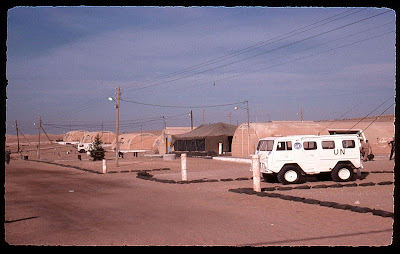(Above) The Unit Insignia of the Highland Fusiliers of Canada (HF of C). Twelve of my 13 years of service were spent with the HF of C.
(Above) The Regimental Colour of the Royal Highland Fusiliers of Canada (RHFC). The unit received its "Royal" designation in 1998. However, I served with the HF of C and not the RHFC, having retired from the military in 1986. With the exception of the unit name, the colours are similar, carrying the same battle honours.
(Above) The unit badge of the 73rd Canadian Service Battalion, CCUNEFME. I was posted to Supply Company, Material Control Platoon, Issues Section. Our section issued all supplies with the exception of rations and vehicle parts to all contingents and the UNEFME headquarters.
(Above) The Unit Insignia of the Grey and Simcoe Foresters (G & SF). I served with the G&SF in 1985 and 1986.
(Above) The Regimental Colour of the Grey and Simcoe Foresters
Ranks Held
Ranks Held
(Above) Private [Trained]
(Above) Corporal
(Above) Master Corporal
(Above) Sergeant
(Above) Warrant Officer
(Above) My Medals - The Canadian Peacekeeping Service Medal, The United Nations Emergency Force Middle East Medal, The Canadian Forces Decoration, The Corrections Exemplary Service Medal & Bar.
My UN Tour
with the Canadian Contingent,
United Nations Emergence Force Middle East (CCUNEFME)
18 Nov 76 to 18 May 77
(Above) At the airfield in Ismailia, Egypt. This picture was taken prior to my boarding the aircraft in the photograph below.
(Below) A Buffalo aircraft from the 116 Air Transport Unit (ATU). The
Canadian Contingent was based at the Al Gala airfield camp in Ismailia,
Egypt. Canadians and a contingent from Poland shared part of the camp.
The Egyptian military had a substantial presence in other parts of the
camp.
(Above) I took this picture while visiting the Canadian War Museum on Ottawa in August 2011. It is a painting of a 116 ATU Buffalo aircraft at the Al Gala airfield camp. The painting was part of the museum's UN peacekeeping display.
(Below) The view room from the front of my barracks in Egypt.
(Above) The view from the rear of my barracks in Egypt.
(Below) I had to add a picture of the pyramids.
(Above) This is a picture taken of the side of a pyramid looking up to the sky. It is a man-made wall of stone going straight up. Pyramids are massive, and I cannot figure out how they were made.
(Above) Sand drifts on the road in the Buffer Zone, territory occupied by the UN in the Sinai desert that separated Egypt and Israel.
(Above) A Swedish camp in the Sinai.
(Above) Approaching Swedish Checkpoint 751 on high ground in the Buffer Zone, overlooking Israel. Israel is about 500 metres beyond this checkpoint at the base of a steep hill.
(Above) Me in Tel Aviv, Israel.
Other Pictures
(Below) My steel cutting project at the Demolition Instructor (All Arms) course at the Canadian Forces School of Military Engineering, CFB Chilliwack (B.C.), Summer 1980.
(Above) The final result.
(Above) Sgt. P.D. Buglass, Winter 1980
(Above) Warrant Officer P.D. Buglass in an Grizzy armoured vehicle at the Meaford training area in August 1986.
The Peacekeeping Memorial, Ottawa
(Above) Me at the memorial.











































.svg.png)
.jpg)




